Everyone knows that dogs are considered to be man’s best friend. They are known for their undying loyalty, obedience, and, of course, their intelligence.
Most dog owners love their furry friends for their personalities, not for their brains, but there are a lot of reasons to value a smart cookie when you know you’ve got one.
All dog breeds are smart per se, but there are some remarkable differences between individual dog breeds when their level of intelligence is concerned.
Some breeds like the Bloodhound are known to be a bit daft around the edges, while others, such as Labrador Retrievers, are praised for their wits.
Accurately measuring just how intelligent dogs are used to be a difficult thing to do before Stanley Coren, a professor of canine psychology at the University of British Columbia, published an internationally recognized and peer-reviewed study on the topic, and then later, a book in 1994 called, “The Intelligence of Dogs”.
In the book, professor Stanley Coren ranked 79 different dog breeds by their level of intelligence in terms of their trainability.
The three main aspects of intelligence in dogs described by Stanley Coren are:
• Working and obedience intelligence – the dog’s capacity to learn new commands
• Instinctive intelligence – the dog’s competence to perform tasks it was bred for
• Adaptive intelligence – the dog’s problem-solving ability
The one thing that binds these three types of dog intelligence is the desire and capacity to successfully interact and communicate with humans, whether it’s understanding commands or following through on them.
For dog owners who want to train their dogs to become therapy dogs, police dogs, hunting dogs, or perform complicated tasks such as search-and-rescue, an intelligent dog breed is a must-have. The smarter the pooch is, the more trainable it is.
We will focus on these three main intelligence aspects as they will be the criteria for our list of the top 20 smartest dog breeds in the world.
So, let’s dive in and find out just how smart some of our favorite dog breeds are.
20. The Cocker Spaniel.

The Cocker Spaniel is a small- to medium-sized dog that originated in the United Kingdom. It was bred as a hunting dog for the purpose of hunting wild game.
Currently, there are two different breeds of this dog type: the American Cocker Spaniel, and the English Cocker Spaniel.
A charming and loving companion dog breed, the Cocker Spaniel is known for its easy-going personality that makes it a good addition to any household.
These dogs are at their happiest when their family is pleased. They will happily snuggle with you on the couch, but they’ll also enjoy playing in the yard with your children.
Although they crave attention most of the time, Cocker Spaniels are also known to value their privacy. On rare occasions, they will want to be left alone to pawnder life’s biggest mysteries.
Cocker Spaniels are smart, adaptable, and cheerful. They always do their best to please their humans, and they love receiving and showing affection.
19. The Brittany.
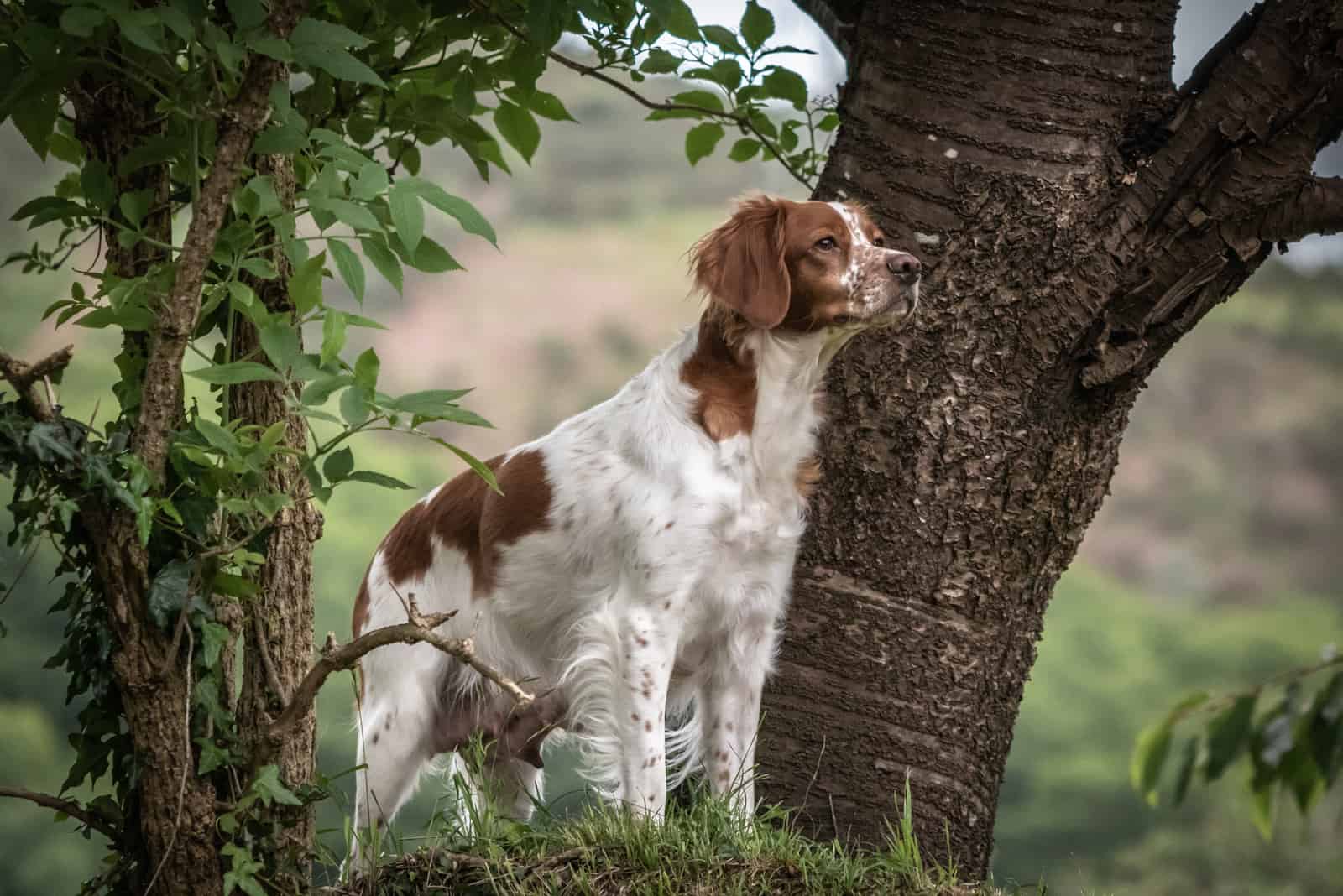
The Brittany Spaniel is a breed of gundog from the Spaniel family that originated in France in the early 1900s. It was created to be the perfect bird hunter.
Today, Brittany Spaniels are dogs that shine in fields such as companionship, guard duty, and field duty.
Their intelligence and good temperament make them good dogs for novice dog owners. Although they’re happy and affectionate dogs that enjoy the company of children, their exuberant nature can sometimes make them incompatible with other pets.
However, when in the company of other boisterous dogs that match their energy level, they very quickly become the best of playmates.
Brittanys are lively and smart dogs that are easily trainable. With plenty of positive reinforcement, praise, and dog treats, training your Brittany will be as easy as a walk in the park.
Nowadays you can find many crossbreeds of the Brittany Spaniel with some other dog breeds. So, we suggest you take a look at the list of the Brittany Spaniel mixes and find out whether these dogs inherited intelligence from their Brittany parent!
18. The Flat-Coated Retriever/Standard Schnauzer.

The Standard Schnauzer and the Flat-Coated Retriever share the 18th spot on the list of the 20 smartest dog breeds in the world.
The Flat-Coated Retriever originated in the United Kingdom in the mid 1800s. It was bred as a multi-purpose hunting dog for retrieving both land and water game.
Also known as the wavy-coated Retriever, it is a strong and hard-working hunting dog breed powerful enough to handle big birds and medium-sized land game.
Although intelligent and trainable, Flat-Coated Labs are sensitive and don’t respond well to harsh training techniques. They need plenty of praise and positive reinforcement, and when treated well, they prove that their obedience and intelligence are extraordinary.
The Standard Schnauzer originated in Germany in the mid 14th century. It is a sturdy, quick, and agile utility dog that is easily trainable.
With their working dog bloodlines, they are territorial and quick to bark at any sign of trouble, so they make excellent watchdogs.
Standard Schnauzers are clever and dignified, but they can also be mischievous if left alone to their own devices. Their intelligence, coupled with their capacity for affection toward their loved ones, along with their hypoallergenic coat, make them excellent family dogs.
If you are interested in finding a purebred Standard Schnauzer, take a look at our list of top 5 Standard Schnauzer breeders in the US!
17. The German Shorthaired Pointer.
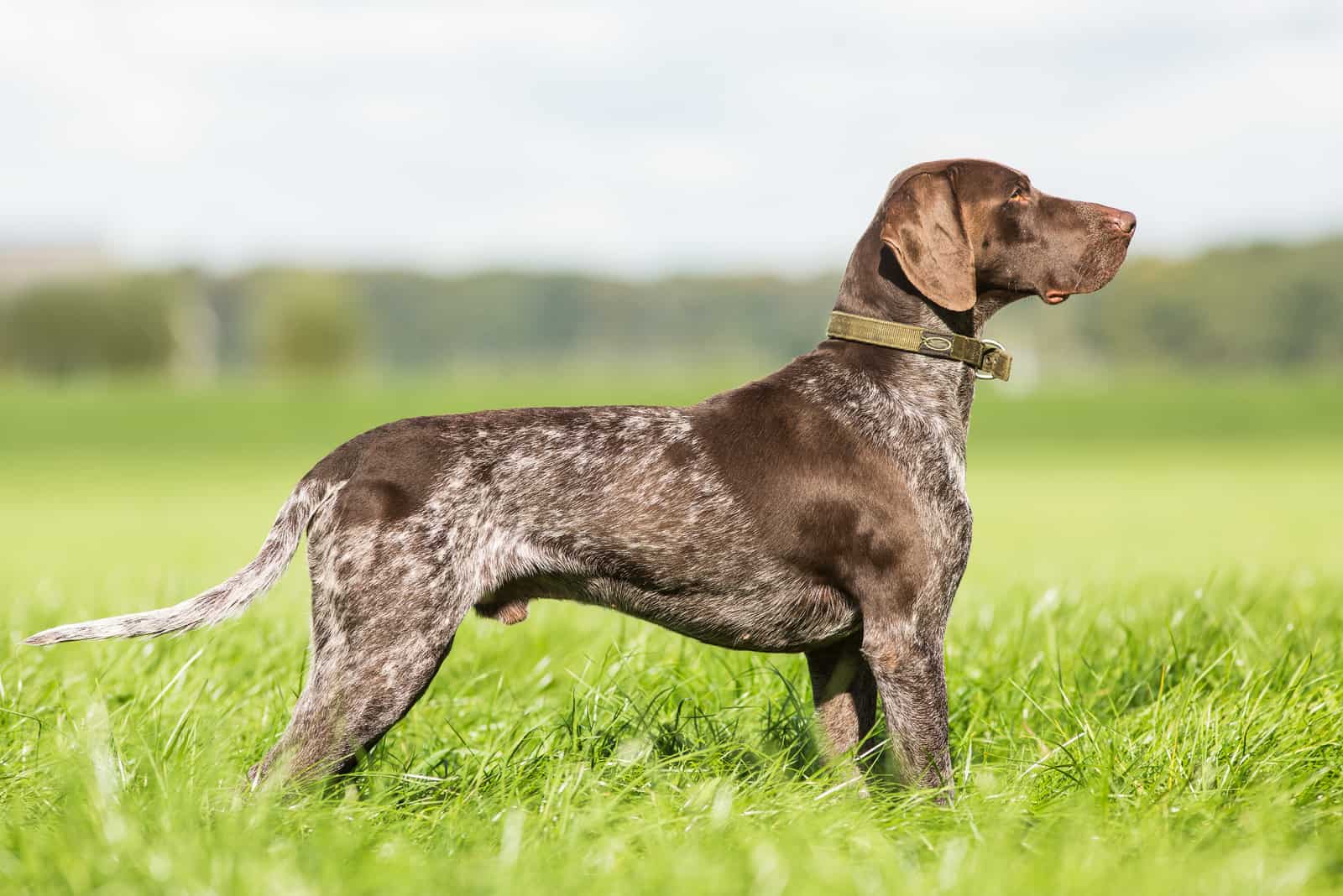
The German Shorthaired Pointer is a medium- to large-sized dog breed created in Germany in the mid 19th century as a hunting dog.
German Shorthaired Pointers are smart, daring, exuberant, free-spirited, obedient, and easily trainable dogs.
Although good with older children, they can be a bit rowdy with younger and smaller kids.
They are always enthusiastic at both work and play. Their people-pleasing personality causes them to be nervous and destructive if left alone for long periods, so plenty of companionship, exercise, and training are key to unlocking their true potential.
16. The Collie/Keeshond.
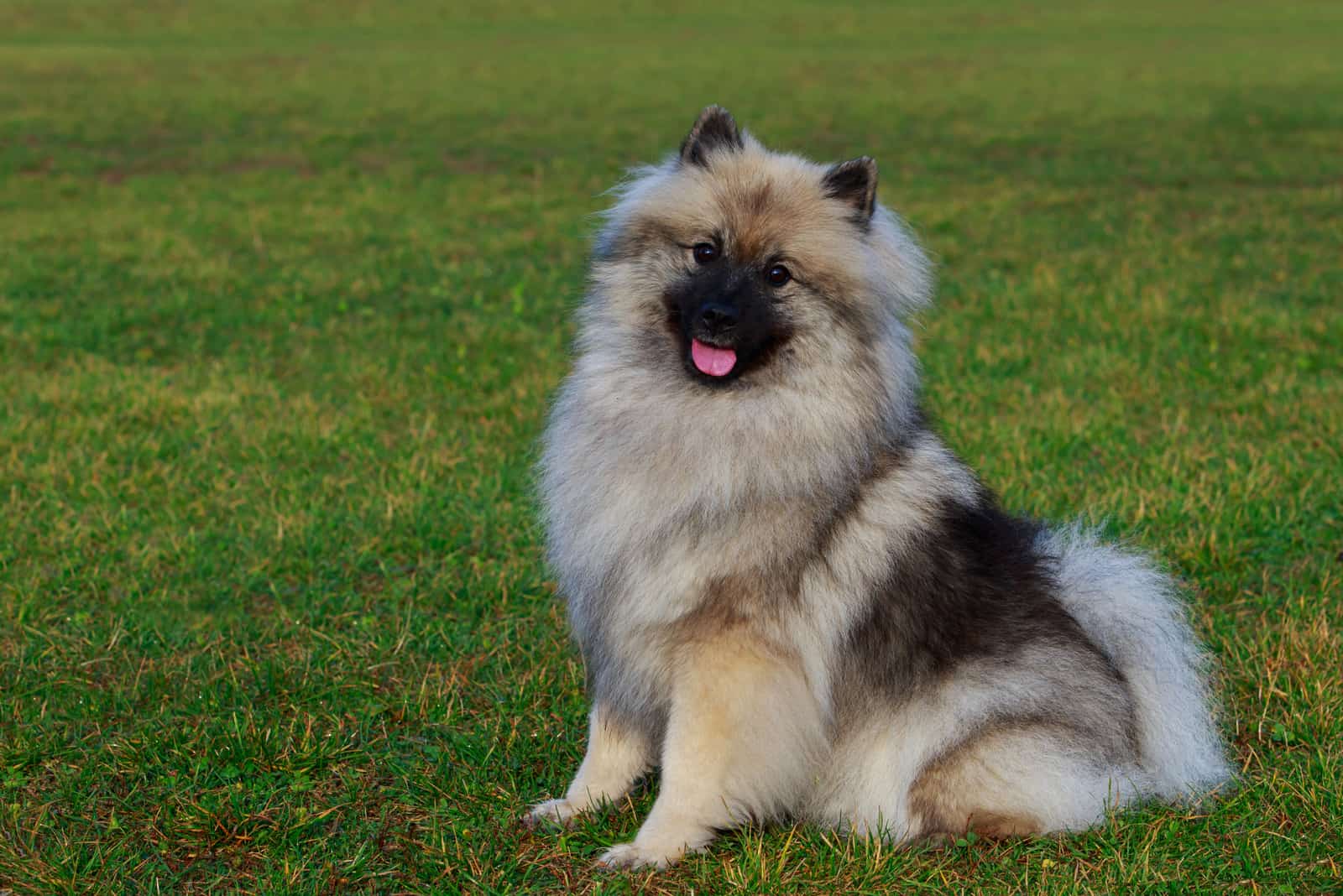
Battling it out for the 16th spot, we have the Collie and the Keeshond; a pair of furry and lovable dogs.
The Collie originated in Scotland in the 18th century. It was primarily bred as a working dog, but today, they are kept as excellent companion dogs or family pets.
When most people think of a Collie, they automatically think of Lassie.
Collies are very emotionally intelligent and in tune with people. Their ability to read their owner’s thoughts is sometimes eerie. If they see a certain need, they take the lead.
The Keeshond is also a medium-sized dog breed with a plush, two-layer coat of silver and black fur and a rough and curled tail that hails from Holland. They were acknowledged by the American Kennel Club in 1930.
They are outgoing, amiable, intelligent, and full of life, which make them the perfect family pet. However, their affectionate personality makes them incredibly trusting toward most humans, so they’re not very effective guard dogs.
Besides being excellent family pets, due to their intelligence and keen observation skills, Keeshonds can proudly strut their hinds in the obedience ring, conformation ring, and in rally competitions.
15. The Belgian Sheepdog/Schipperke.
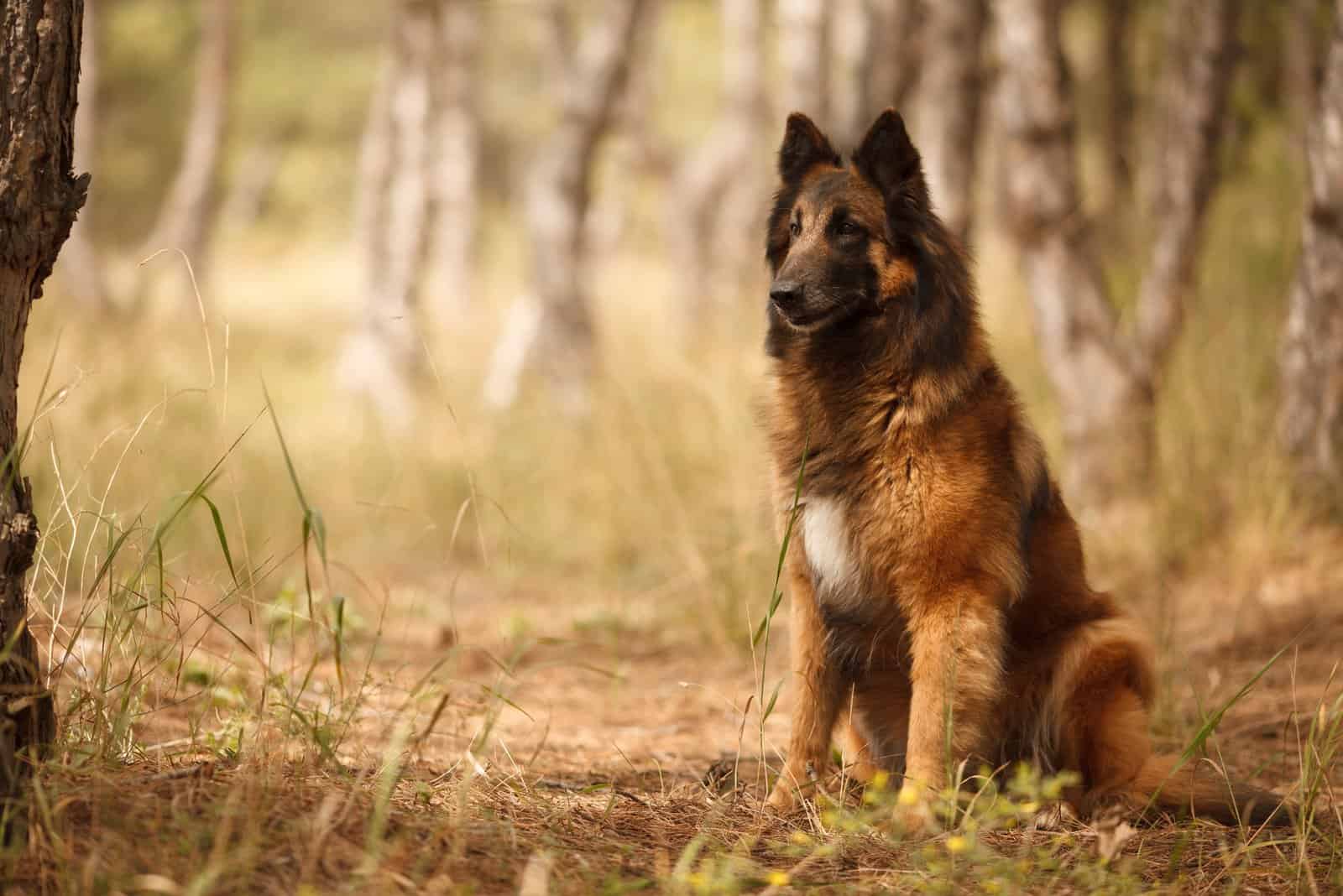
Tied in at the 15th place, we have the Belgian Sheepdog and the Schipperke.
The Belgian Sheepdog, also known as the Belgian Shepherd, is a medium-to-large-sized dog breed; one of the four types of shepherd dogs that were created in Belgium in the late 1800s as herding dogs.
Easily recognizable by its unique black coat, the Belgian Sheepdog is a loyal, energetic, and smart dog that adores kids and gets along well with other pets and animals.
The Schipperke, on the other hand, is a small dog breed that is a descendant of the Belgian Sheepdog that was bred primarily as a watchdog and companion dog.
Their small size and cute appearance are what make these dogs so popular, but a Schipperke’s intelligence and curiosity are almost unrivaled compared to other small dog breeds.
14. The Belgian Tervuren.
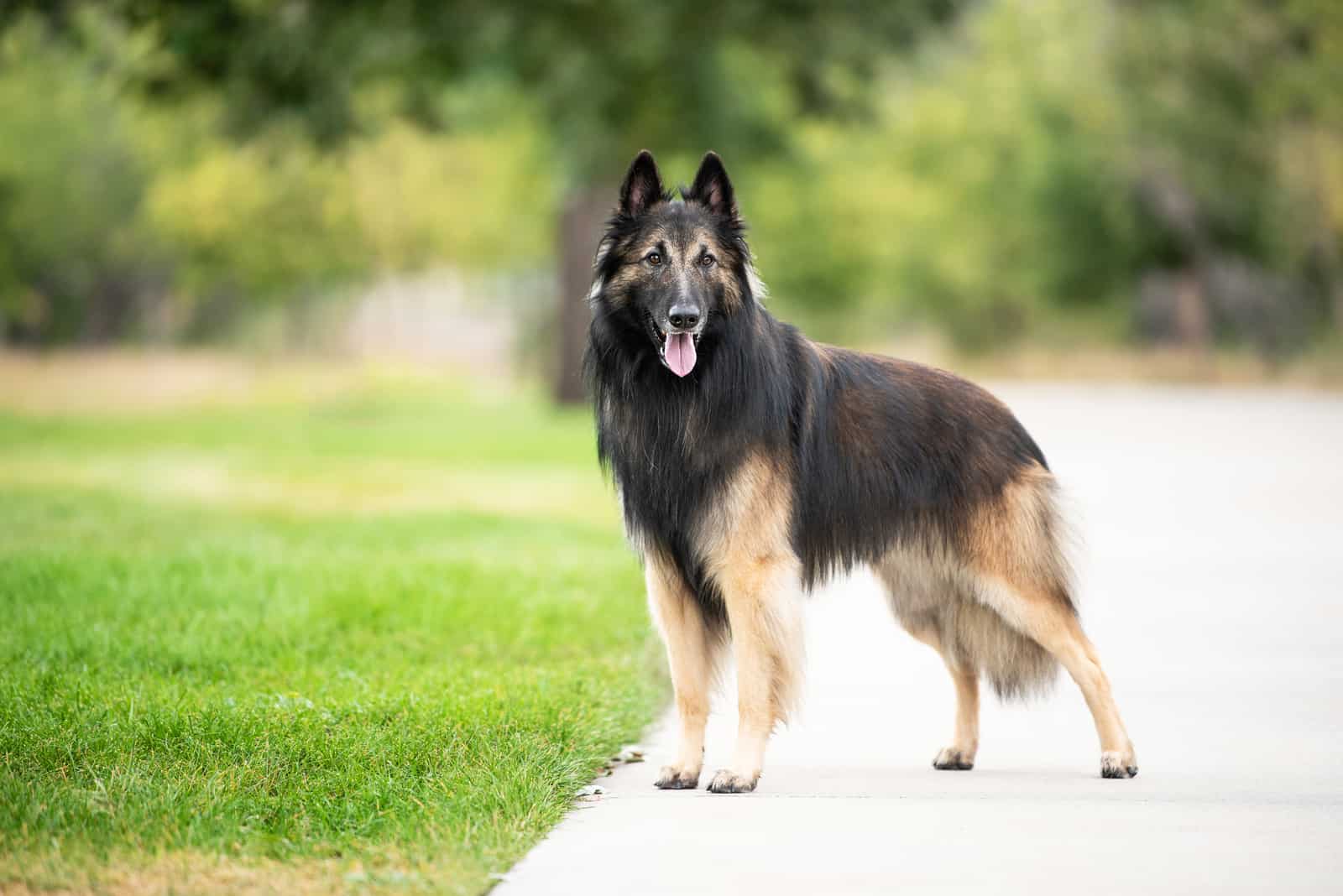
The Belgian Tervuren is another long-coated Belgian shepherd dog originally bred for herding, and it is often mistaken for the Belgian Malinois.
Although they’re still great at it, they’re not just herders anymore. They excel as service dogs, and at agility trials, obedience events, and tracking, and they make wonderful therapy dogs.
Belgian Tervurens are dynamic, lively, and highly intelligent dogs that need to have a job to keep them busy.
They are not typically recommended for novice dog owners because of their temperament and high activity levels.
13. The English Springer Spaniel.
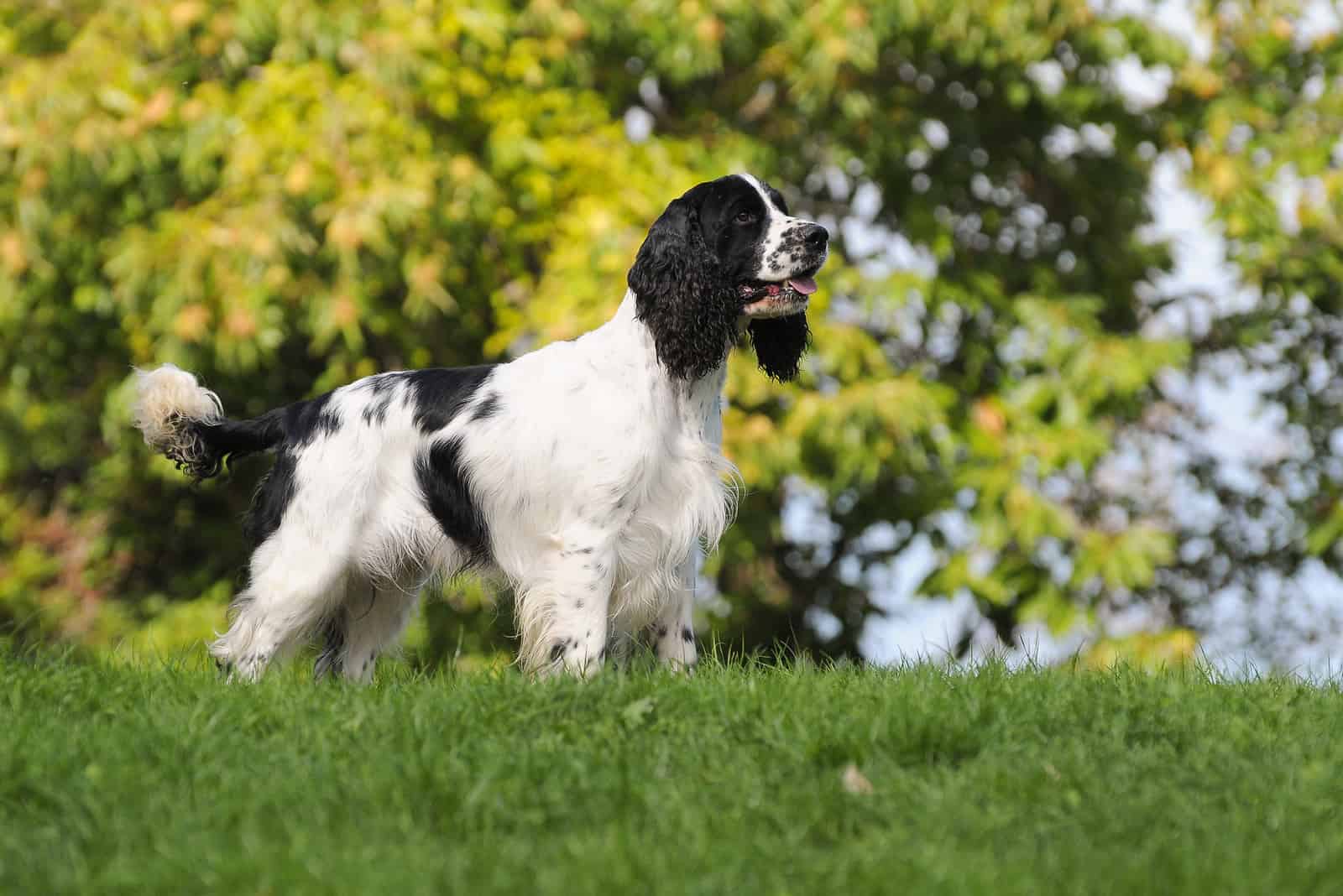
The beloved English Springer Spaniel originated in the mid 18th century in England, and it was created for the purpose of hunting and retrieving wild land game.
They are smart, enthusiastic, and eager to please. They typically get along well with children if they are raised alongside them, and they are very affectionate toward their entire family.
English Springer Spaniels are also known to be good with other pets in the household – that is, all pets except birds because that’s what they were bred to hunt.
The English Springer Spaniel is a very smart and obedient dog breed. Quick to learn and adapt, as well as eager to please and to obey commands, the English Springer Spaniel is a great dog to have around.
12. The Miniature Schnauzer.
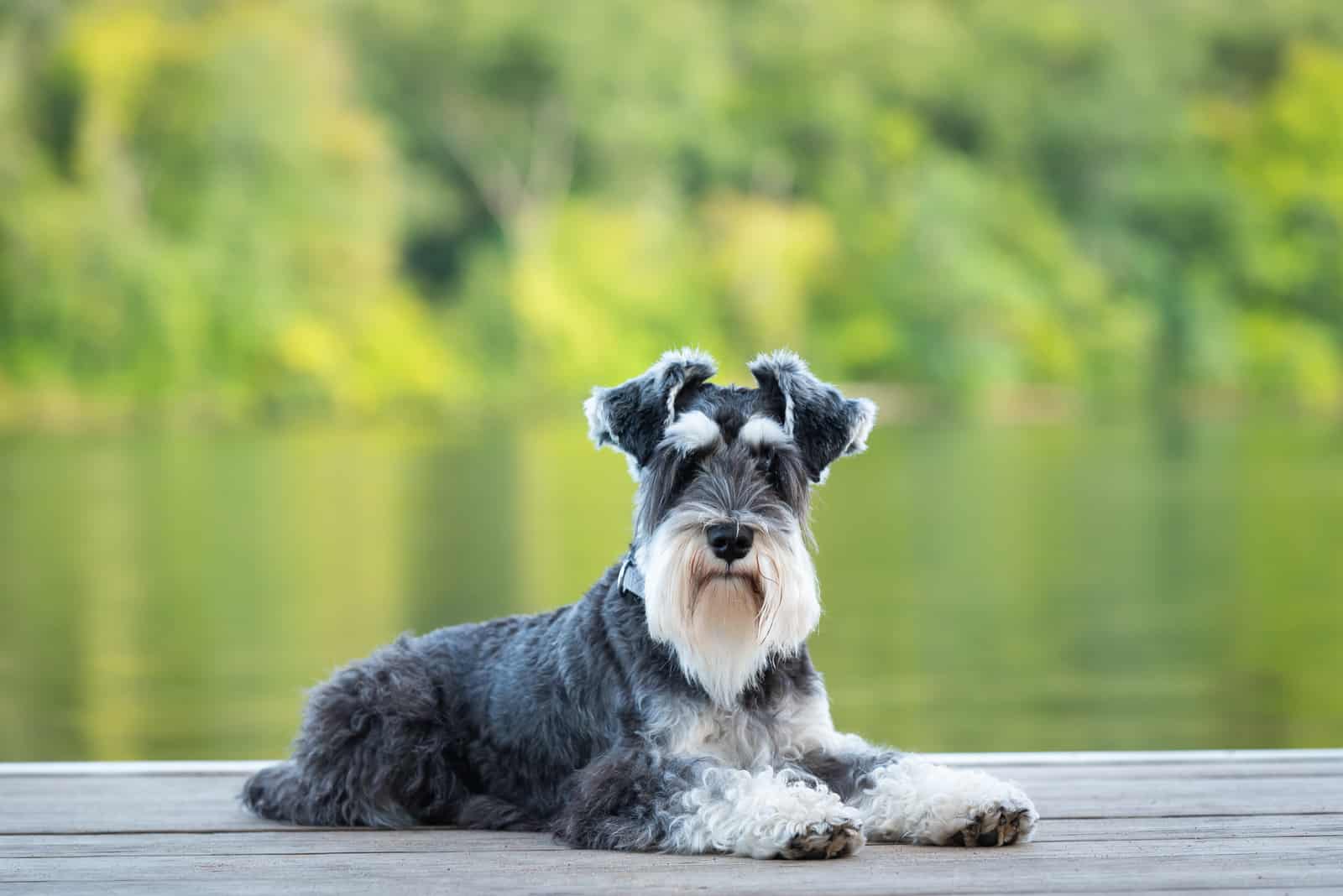
Bred as a cross between the Standard Schnauzer and one or two smaller breeds, the Miniature Schnauzer is a small German breed originally used as a ratting dog.
These dogs pack brains, affection, and a big personality all into a small package.
Miniature Schnauzers are courageous dogs with good guarding instincts that don’t have the tendency to nip or bite. Although they are lively and energetic dogs most of the time, they can be a bit stand-offish, and they do require a bit of solitude now and then.
Thanks to its high intelligence and good temperament, it’s one of the cutest and most popular dog breeds worldwide.
11. The Pembroke Welsh Corgi.
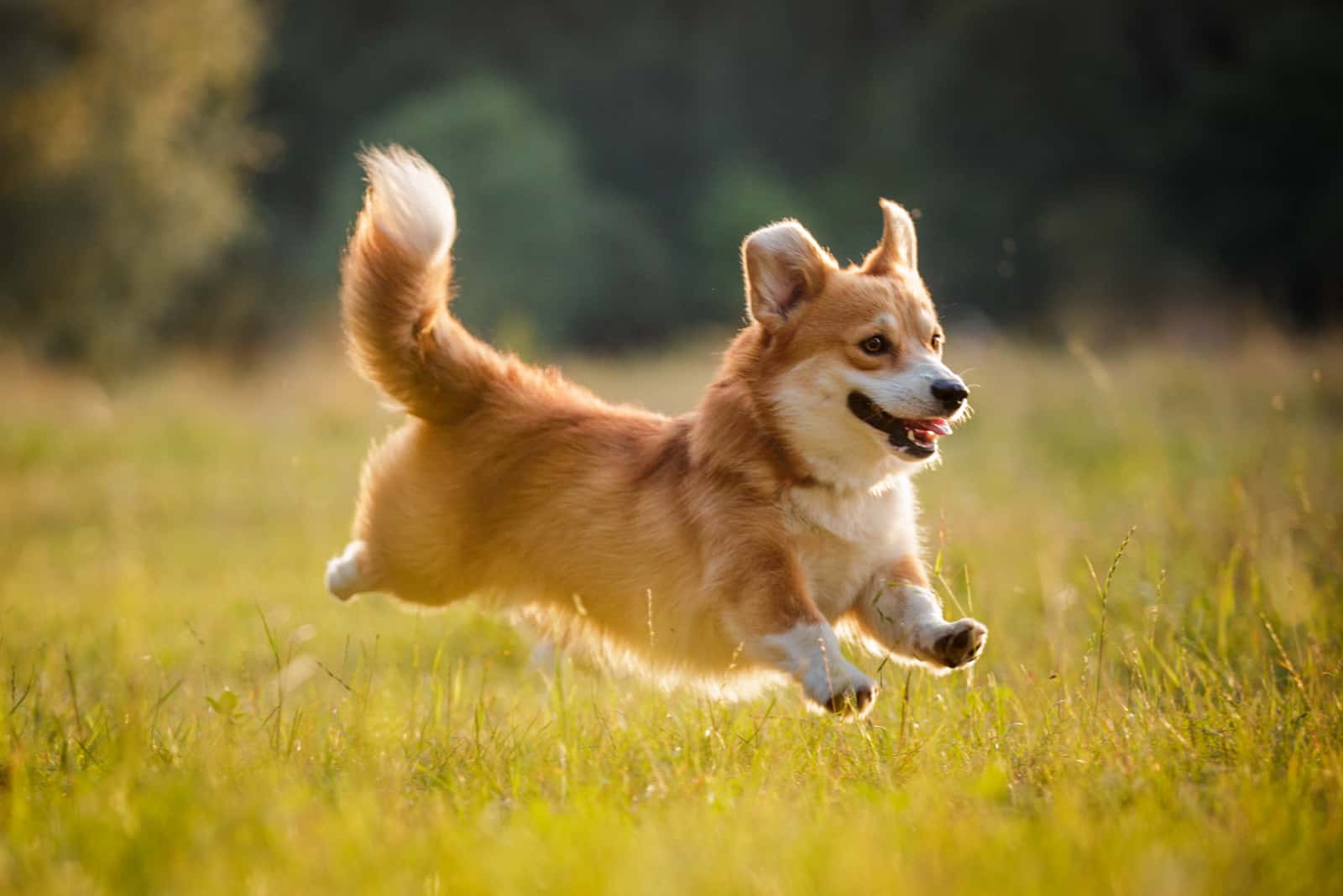
The Pembroke Welsh Corgi (or, as my elderly neighbor likes to call them; the Corg Welshies) originated in Pembrokeshire, Wales. It’s bloodlines date back as far as 1107 AD. They are one of the oldest and smallest herding dog breeds in the world.
Easily distinguishable by their uniquely large upright ears and their tiny dwarf-like build, the Pembroke Welsh Corgi adores being in the spotlight, and is always eager to learn, adapt, and train.
They have also been famously known for their popularity among British royalty for over 70 years now.
They are dynamic, affable, and agile little herders that are loving and compassionate without being too clingy.
They are known for being affectionate and intelligent, but they can sometimes have a stubborn streak. They are trainable, but not completely subservient. They like to walk around with their head held high, which might just be a side-effect of all the British royalty they hang around.
10. The Australian Cattle Dog.
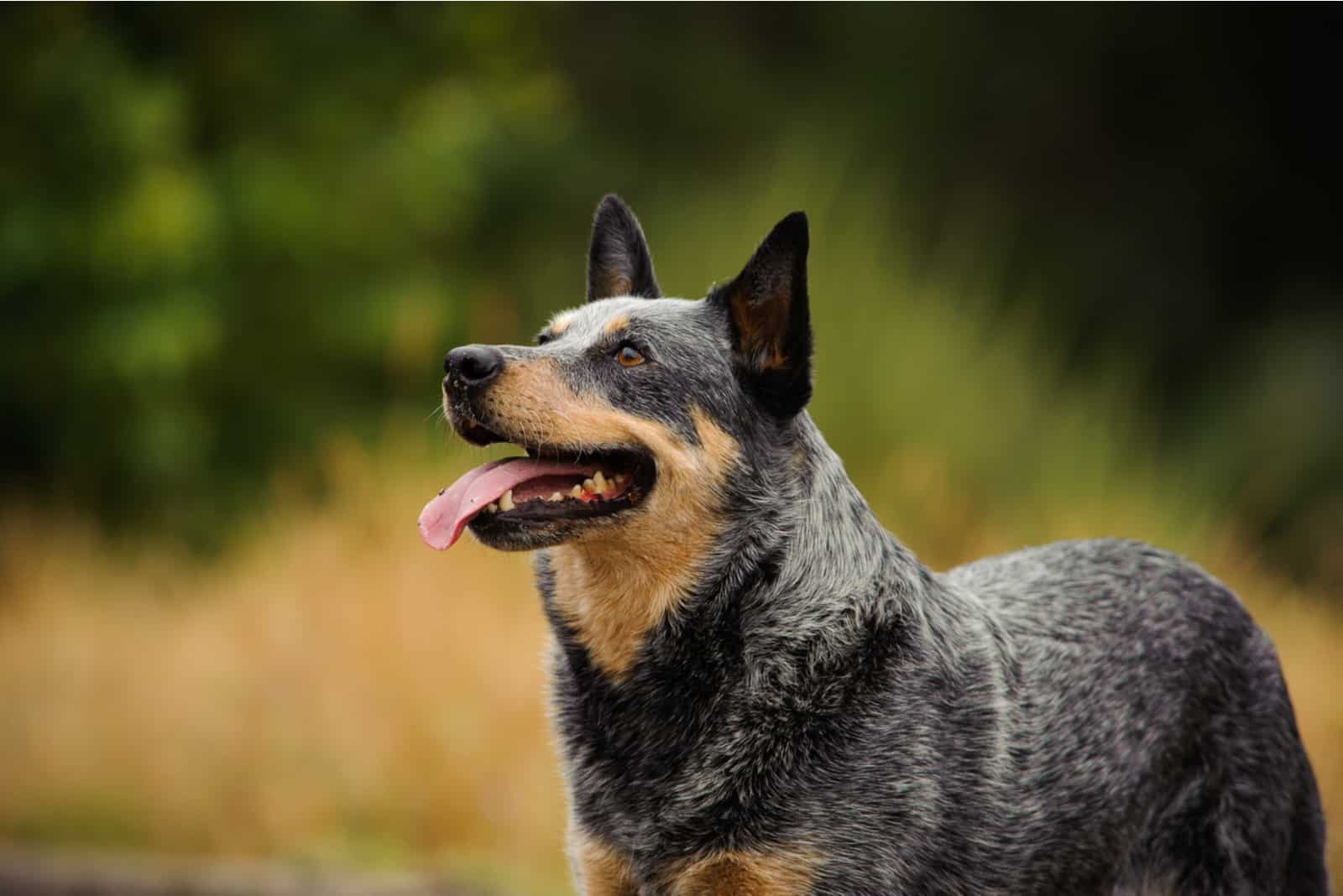
Another breed of herding dog, the Australian Cattle Dog, also popularly nicknamed the blue Heeler, was developed in Australia for driving cattle over long distances.
This beautiful Aussie dog breed is usually not the best choice for first-time dog owners or people with a more laid-back lifestyle, but it’s one of the best dog breeds for people with active lifestyles.
Because they are natural working dogs, Blue Heelers need plenty of attention, training, movement, and affection in order to properly develop into well-behaved dogs. If neglected, they tend to become inattentive, reckless, and can even become aggressive towards humans and other animals.
When properly socialized and trained, Australian Cattle Dogs are known for their durability, toughness, intelligence, and easy trainability.
9. The Rottweiler.
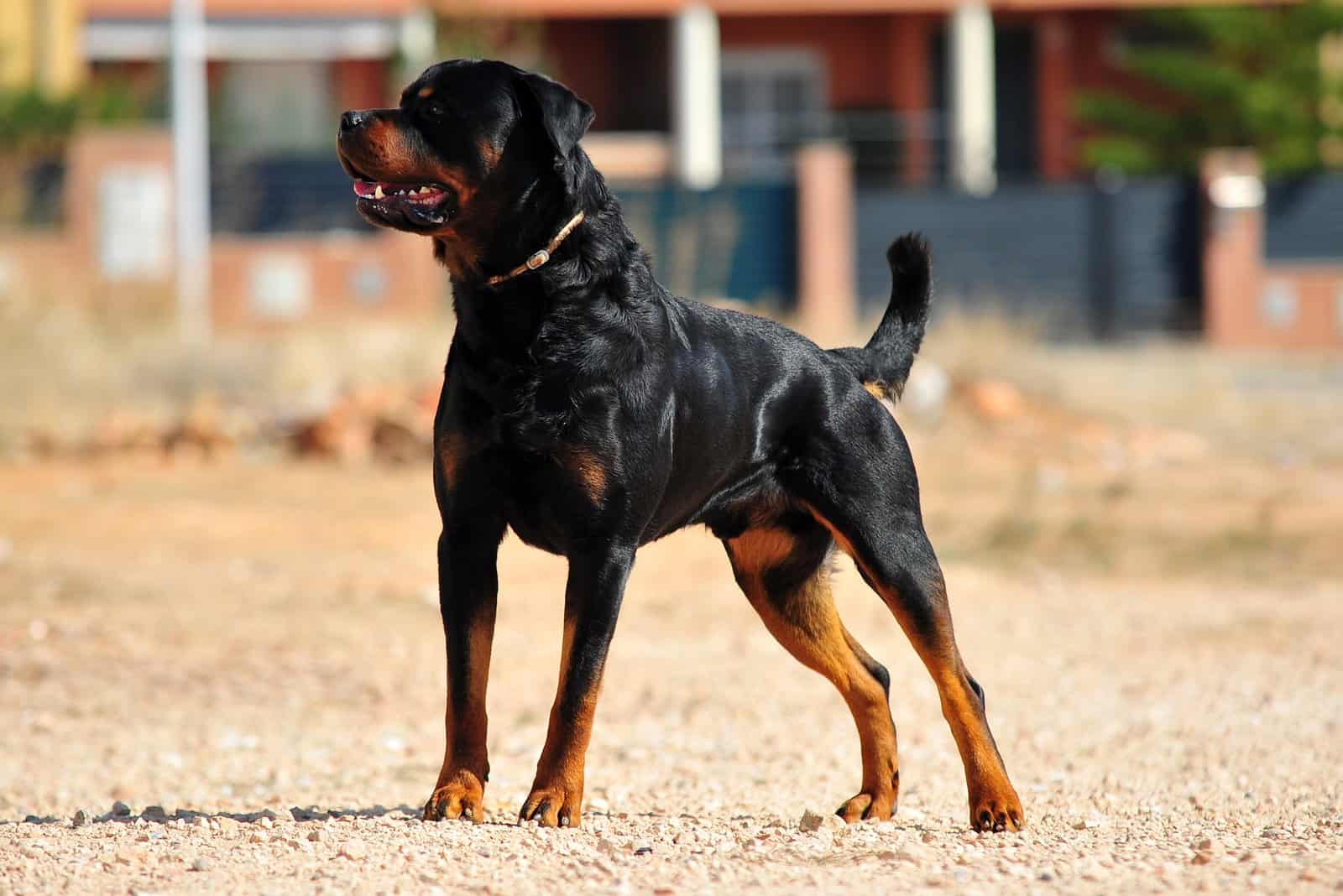
Originally from Germany, the Rottweiler is a robust and muscular large dog breed created by German breeders for pulling loaded carts.
Fierce and powerful, but loving and affectionate, Rottweilers are amazing dogs that can fulfill the role of both a service dog and a family pet. They are known to be especially gentle and patient with children when properly socialized as puppies.
Rottweilers are very smart and highly trainable dogs. When given firm and consistent training, a Rottie will learn how to coexist peacefully with any other animal in the household.
Nowadays, thanks to their friendly temperament, superb intelligence, and willingness to work, Rottweilers are often used as guide dogs, therapy dogs, police dogs, and search and rescue dogs.
8. The Papillon.
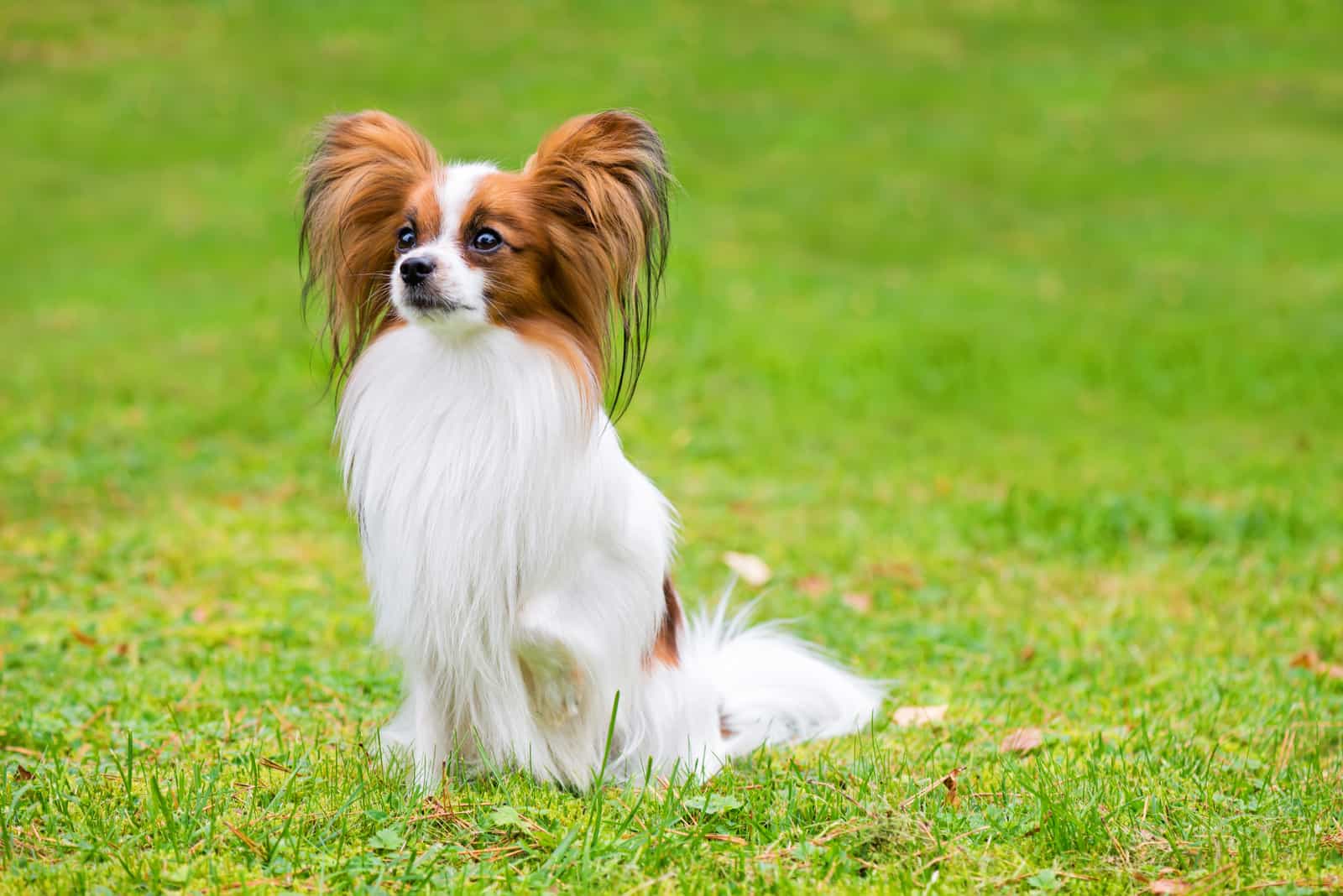
Originally bred in France as a ratting dog, the Papillon is a popular lap dog known for its witty temperament and friendly attitude.
Distinguishable by their unique butterfly-esque look, with long and spiky hair on their ears, Papillons are dogs that belong to the Toy Spaniel family.
Although their stature may be tiny, they make up for it with huge personalities and high intelligence.
One Papillon has even been the first and only dog in history reported to win all three of the most important international dog shows in the span of a single year.
Another Papillon was reported to have obliterated the breed record at the WKC dog show in the master’s agility competition.
Because of their high intelligence and amazing adaptability, Papillons are extremely fast learners. Incredibly, it takes the average Papillon fewer than five repetitions to learn a new command.
So, the next time someone says a big brain is needed for a high IQ, tell them about the tiny but borderline genius Papillon and blow their mind.
7. The Labrador Retriever.
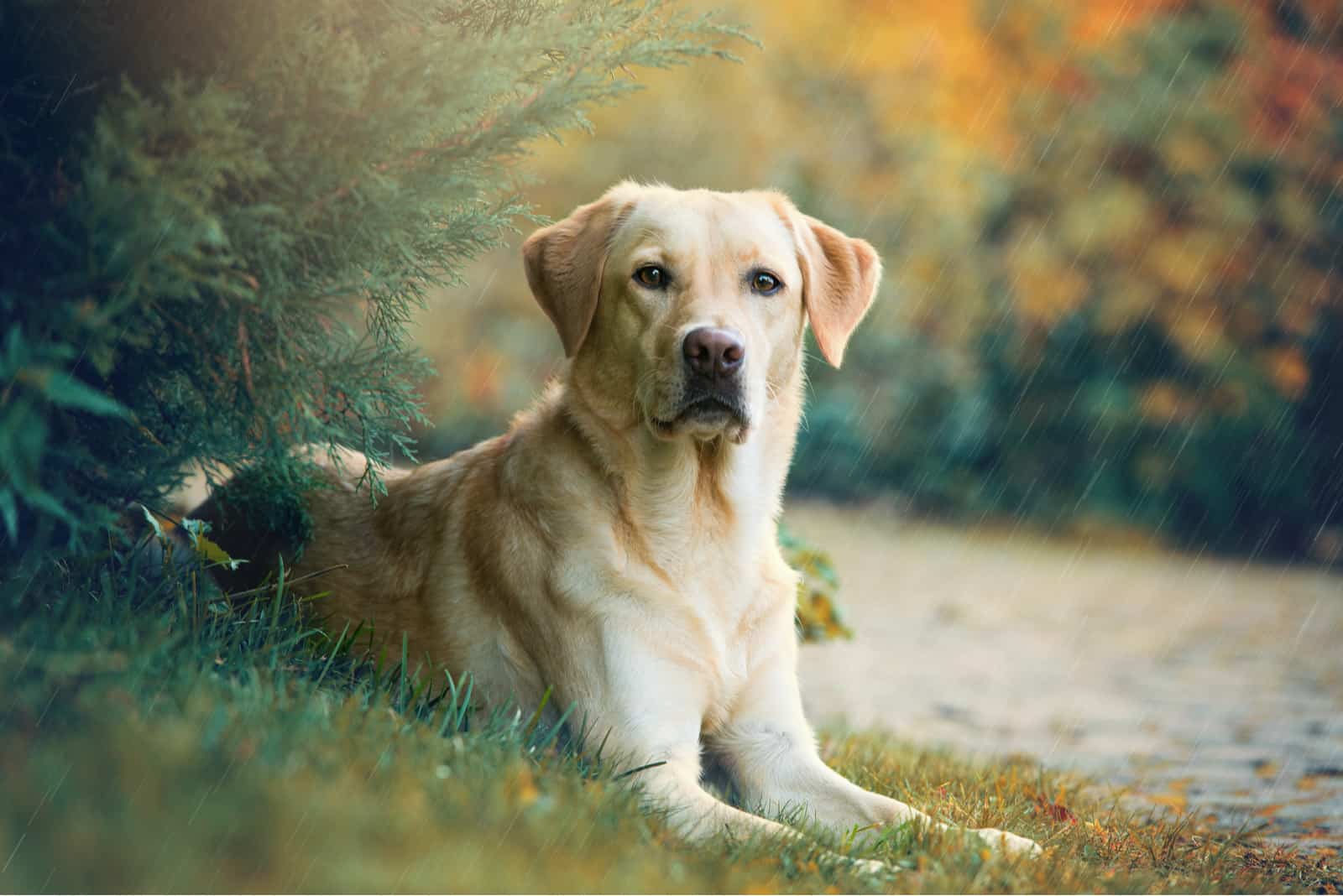
The Labrador Retriever (also popularly known as the Lab) originated in the 1830s in Canada where it was bred as a waterfowl hunter.
Today, it’s one of the most popular breeds in the entire world.
Despite its name, which refers to the province of Newfoundland and Labrador, in Canada, the ICF recognizes the origin of the Lab as British.
They were bred in the 1830s when St. John’s Water Dogs were crossed with British hunting dogs to develop what are now known as Labrador Retrievers.
It is a beautiful, intelligent, and noble dog breed that is great with children and other pets, which makes it suitable for all family types.
It is relatively easily trainable due to its sociable character and predisposition toward affection and treats.
They need lots of exercise and mobility to stay happy, healthy, and agile. If neglected, their laid-back personality might cause them to become lethargic and uninterested in daily activities, which is why it’s crucial to spend a lot of time playing and walking with them.
Known for their high intelligence and friendly character, Labrador Retrievers are often trained as exceptional therapy dogs and guide dogs.
6. The Shetland Sheepdog.
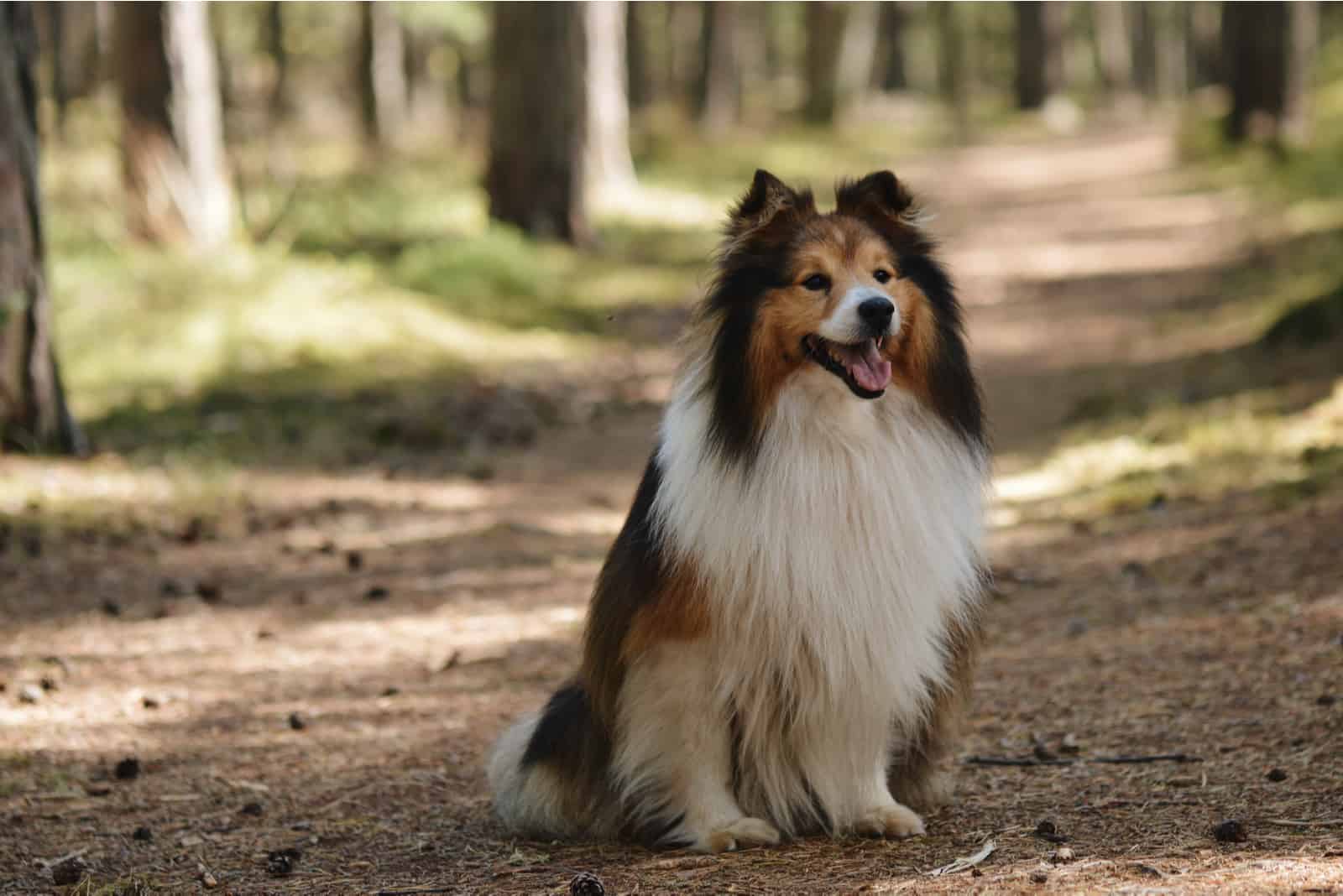
The Shetland Sheepdog (also known as the Sheltie) is a small- to medium-sized dog breed that originated in the Shetland Islands of Scotland where it was bred to be used as a utility dog for farming and herding.
Shelties are buoyant, sensitive, and highly energetic dogs that are always willing to learn, play, and work hard.
They are extremely intelligent, quick, and obedient. Shelties are incredibly loyal to the point where they are often referred to as their owners’ shadow.
Truth be told, Shelties are known to be a little too smart for their own good. It’s no wonder why they are this far up on the list of the 20 smartest dog breeds in the world.
This is a breed that needs a purpose. If not provided with plenty of mental stimulation, Shelties quickly become uninterested or bored, and will invent their own entertainment when left to their own devices, which most of the time, won’t be to their owner’s liking.
5. The Doberman Pinscher.

Named after a German tax collector, the Doberman is a medium-sized dog breed that originated in the 1890s in Germany. It was primarily created to be a guard dog.
At first, they were trained to be fierce and intimidating, but nowadays, they’re known for their friendly disposition, which makes them excellent family pets.
The average dog can learn a new command in 25 to 40 repetitions, whereas the Doberman Pinscher is able to learn a new command in under five repetitions. The average dog that is asked to perform a known command will obey 50% of the time, while the Doberman will perform the given task 95% of the time.
Dobermans are great working dogs, and they excel at just about any AKC working dog event that they’re put through including fly ball, dock diving events, disc dog events, barn hunting events, and so much more.
Because they are extremely intelligent, obedient, and capable dogs, they are among the favorite dog breeds used by the U.S. military and tons of other private organizations worldwide as police dogs, bomb detection dogs, service dogs, and much more.
In fact, one of the most well-known search-and-rescue dogs helping out with recovery efforts at ground zero on 9/11 was a Doberman Pinscher.
4. The Golden Retriever.
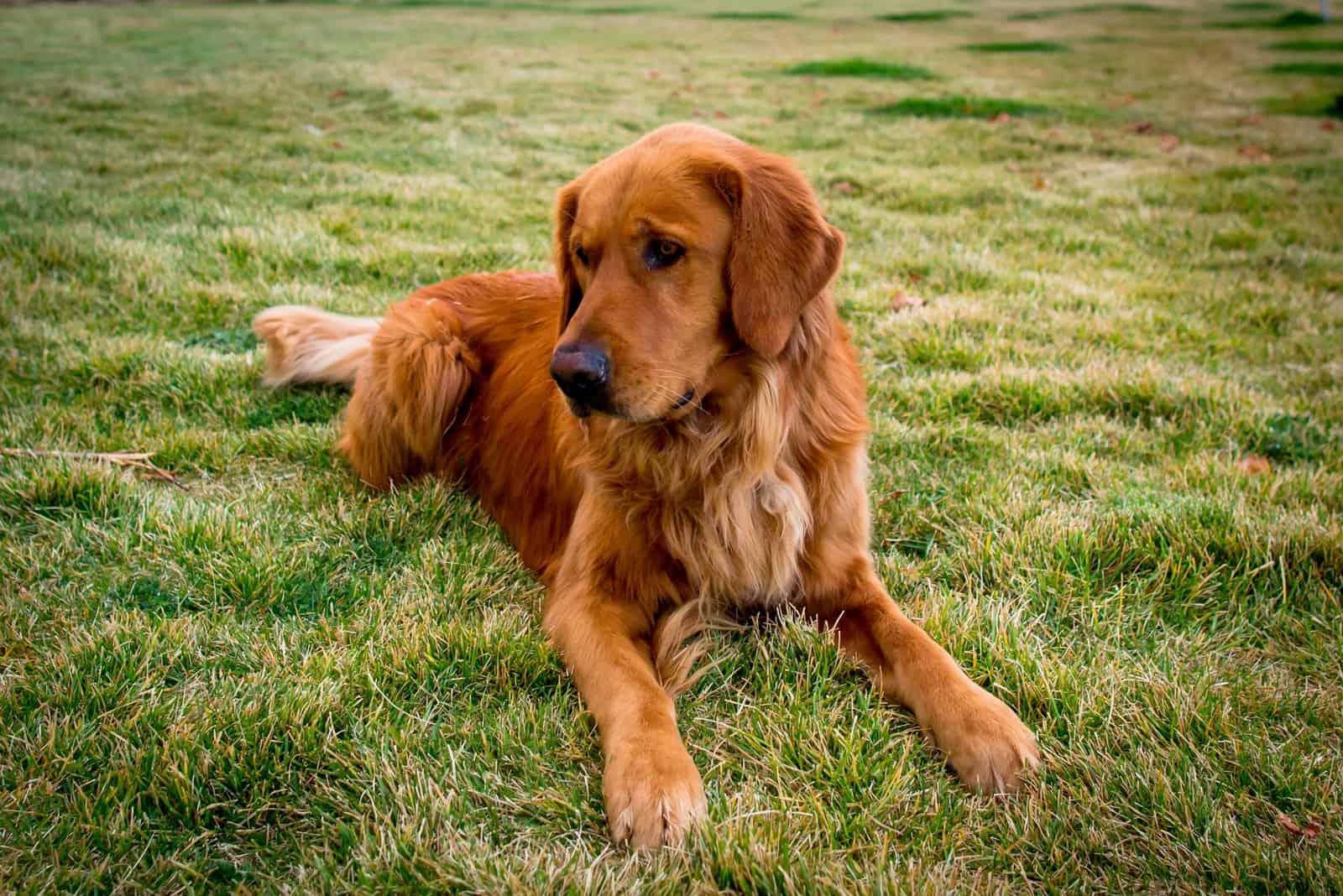
The Golden Retriever is a large dog breed that originated in Scotland in the late 1800s. They were originally bred for hunting and retrieving waterfowl.
They are excellent and energetic swimmers, and they can be trained to perform all sorts of tasks. Goldies are known to range from incredible police dogs as sniffers and search-and-rescue dogs, to amazing therapy dogs and all-around family pets.
Personable, loving, easy-going, and general goofballs, Golden Retrievers are an incredibly popular choice for families all over the world.
Golden Retrievers can fulfill all kinds of roles such as hunting, threat detection, assistance, search-and-rescue, therapy, etc.
3. The German Shepherd.
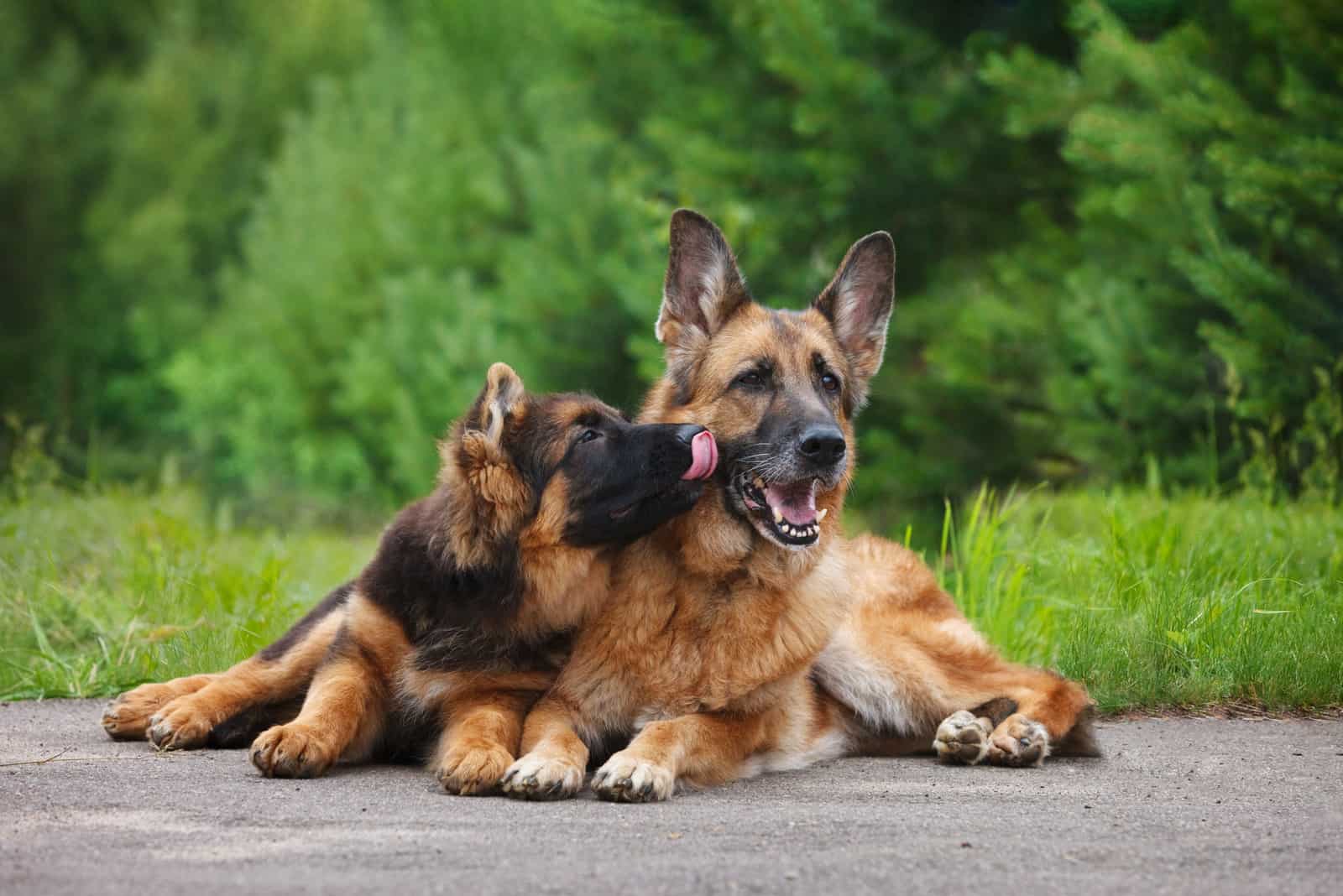
The German Shepherd (also known as the Alsatian) originated in the late 1800s in Germany where it was bred as a high-energy herding dog.
Even though they might appear threatening, both male and female German Shepherds are actually very sensitive and intuitive.
Although they were primarily bred for herding, today, German Shepherds are widely utilized by police and military forces because of their innate intelligence, amazing sense of smell, and eagerness to quickly and accurately follow orders.
The German Shepherd is a highly active dog breed that needs tons of daily exercise if they are to develop into well-behaved adults. So, if you live in a small apartment or house, be sure to take them out for long walks or runs every single day.
However, even though they are highly active, German Shepherds also need some well deserved downtime after a long and grueling day at the pawffice.
2. The Poodle.
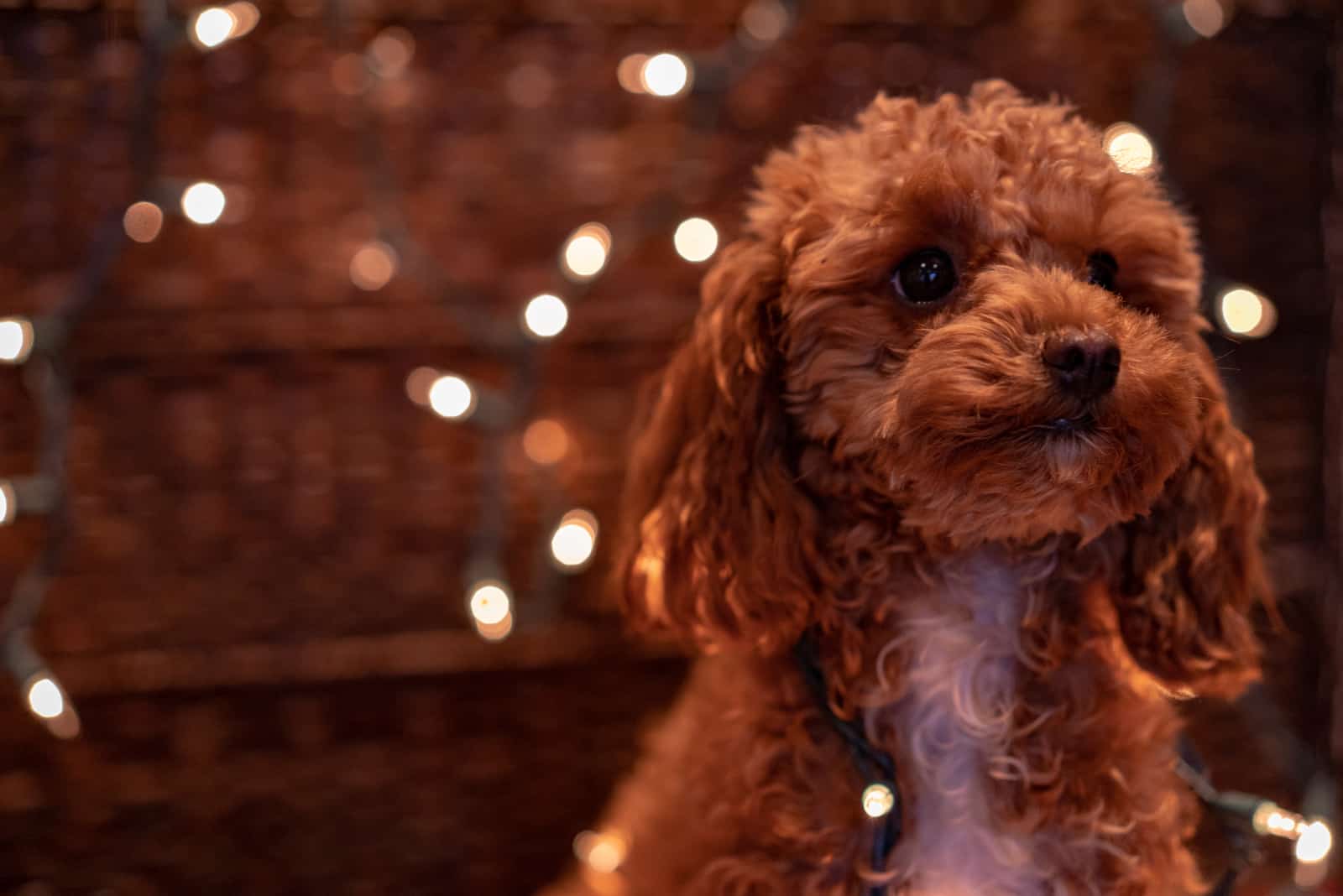
Even though it’s famously called the French Poodle, this beautiful and curly hunting dog breed actually originated in Germany. They are thought to have been around ever since the 15th century.
The Poodle is one of the most favored show-dog breeds in the world, apart from being one of the most popular choices for family pets.
They are famously known for their intelligence and ability to quickly learn new tricks and commands.
Like all other dog breeds, they require training, socialization, and lots of mental stimulation to stay in a sound body and mind.
Apart from being known to be great with small children, they are also known to be hypoallergenic dogs, which makes them a great option for families with children who are sensitive to dog hair.
1. The Border Collie.
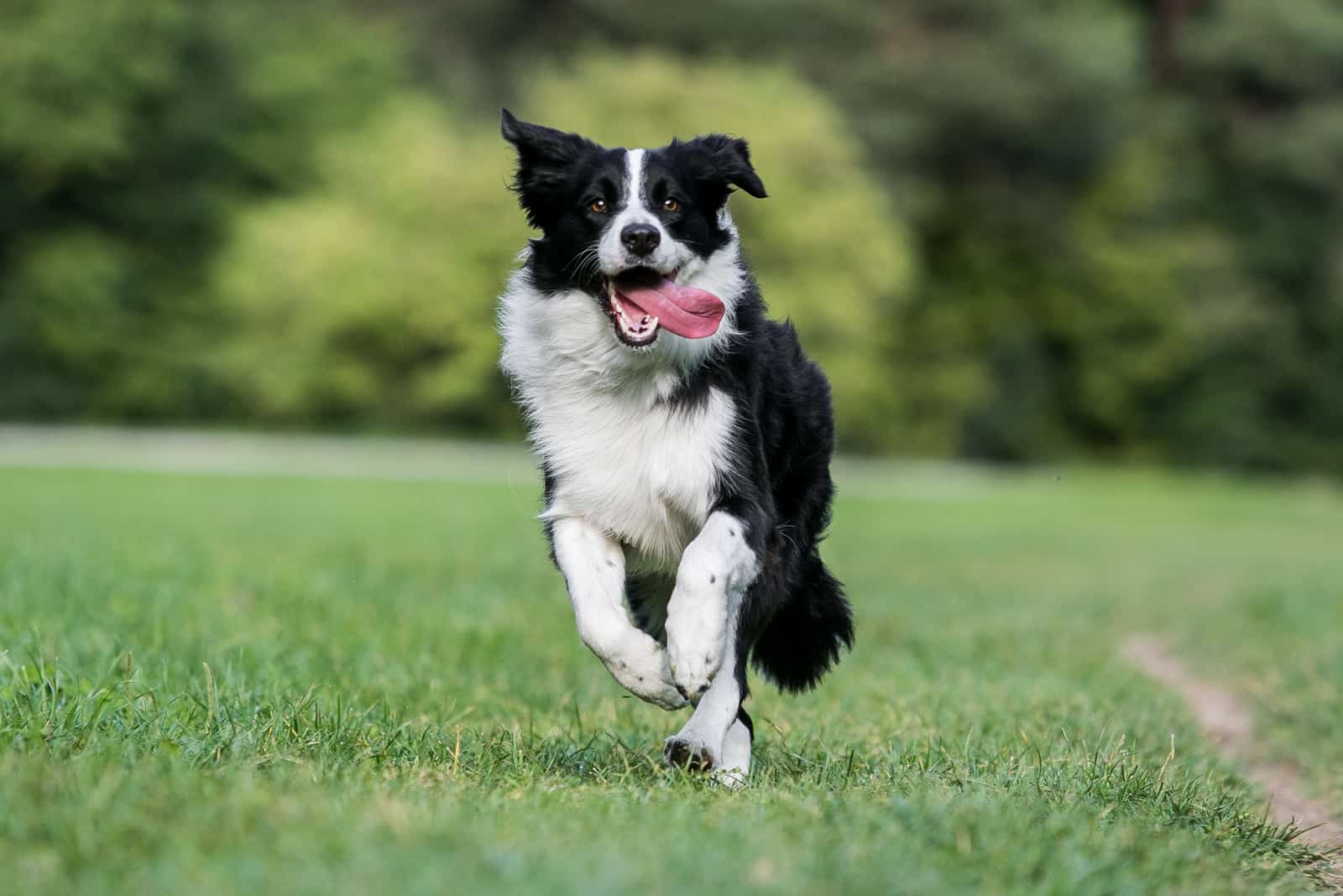
The Border Collie originated around 2000 years ago in the ancient Roman empire. Later, around 1200 years ago, they were bred and developed in Scotland into what they are today… the perfect herding dog.
Their incredible level of intelligence makes them excel as herding dogs, working dogs, guard dogs, therapy dogs, and search-and-rescue dogs.
You name it, they can do it! This is why the Border Collie deserves the number one spot on the list of the smartest dog breeds in the world.
As Border Collies are very active dogs, they need equally active owners who are prepared to exercise with them on a daily basis.
People who enjoy camping, running, hiking, or basically any outdoor activity will find that the Border Collie is the perfect companion dog for them.
When lacking mental and physical stimulation, Border Collies exhibit obsessive and destructive behaviors as they search for creative outlets for their pent-up energy.
To give you an idea of just how smart these pups can be, here’s a fun fact. One Border Collie, named Betsy, was reported to learn over 340 words and acted consequently to human citation of those words, while another Border Collie, named Chaser, was capable of identifying 1022 different toys.
How To Test Your Dog’s Intelligence

Photo from: @cuutebebe_germans
Now that you know what the top 20 smartest dog breeds in the world are, if your furry friend is not among these breeds, you’re probably wondering just how smart your pooch really is.
One way to test your puppy’s intelligence level is to perform an IQ test consisting of five individual tasks. Try it out and see just how smart your pup is.
Test #1
This is a test of your dog’s problem-solving ability.
Get a large towel or blanket and let your dog smell it and become familiar with it.
Once this is done, place the blanket over your dog’s head. Prepare a stopwatch to measure the time it takes your dog to get free of the blanket.
Points:
• If your dog frees itself from the blanket in less than 15 seconds, give it 3 points
• If it takes around 15 to 30 seconds, that’s 2 points for your pooch
• If it takes your pup much longer than 30 seconds, give it 1 point for trying
Test #2
Again, prepare a stopwatch to measure your dog’s speed in this test.
Place a tasty dog treat beneath a towel on the ground and wait to see how long it takes for your pooch to figure it out and get the treat.
Points:
• Under 15 seconds – 3 points
• 15 to 60 seconds – 2 points
• More than 60 seconds – 1 point
Test #3
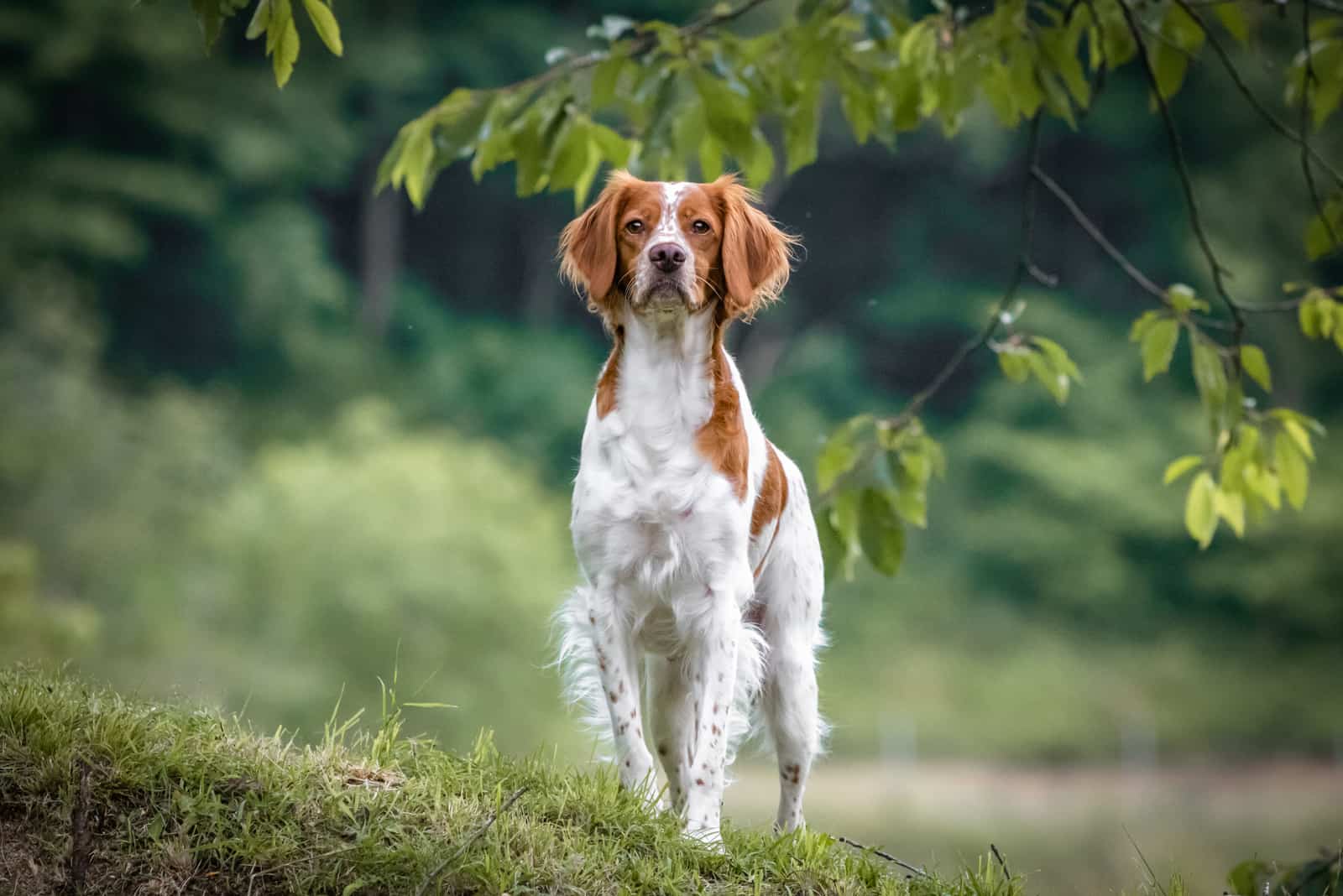
This is a test of your dog’s information retention, or memorization ability.
Take three empty cups and place them next to each other upside down on the floor.
With your puppy watching, place a treat under one of the cups, then distract it for a few seconds before starting the test.
Points:
• If it chooses the right cup on the first try – 3 points
• If it tries one empty cup first, but then finds the treat – 2 points
• If it finds the treat on the third try – 1 point
Test #4
This is a test of your dog’s reasoning skills and determination.
Place a tasty dog treat within the dog’s reach under a lower piece of furniture like a couch where the dog can see it, then start the timer.
Points:
• If it takes the dog less than a minute to grab the treat using only its paws – 3 points
• If it tries to reach it with both its mouth and paws first – 2 points
• If it gives up trying to reach it or doesn’t try at all – 1 point
Test #5
Place a large cardboard barrier with a narrow slit cut out where you will show your dog a treat.
The barrier must be taller than the dog, so that it can’t jump over it, and the slit must be narrower than its head, so that the dog won’t fit through.
Start the timer, and prompt your pup to reach the treat for exactly 60 seconds.
Points:
• If it figures out that it needs to walk around the barrier to get to the treat in under 30 seconds – 3 points
• If it takes longer than 30 seconds – 2 points
• If your dog tries to squeeze through the slit, jump over it, or go straight through the barrier – 1 point
Final Score
To determine your dog’s overall IQ score, add the points of all five tests and compare this to the final scoring below:
• 13 – 15 points total: Your dog is quite the genius.
• 9–12 points total: Your dog’s not exactly Hawking, but it’s still a pretty smart cookie.
• 5–8 points total: Your dog is of average canine intelligence.
• 1–4 points total: Your pup is a special snowflake; it might need some help in figuring things out. Luckily, it doesn’t take brains to be cute, cuddly, and lovable, which is what matters most.
Conclusion
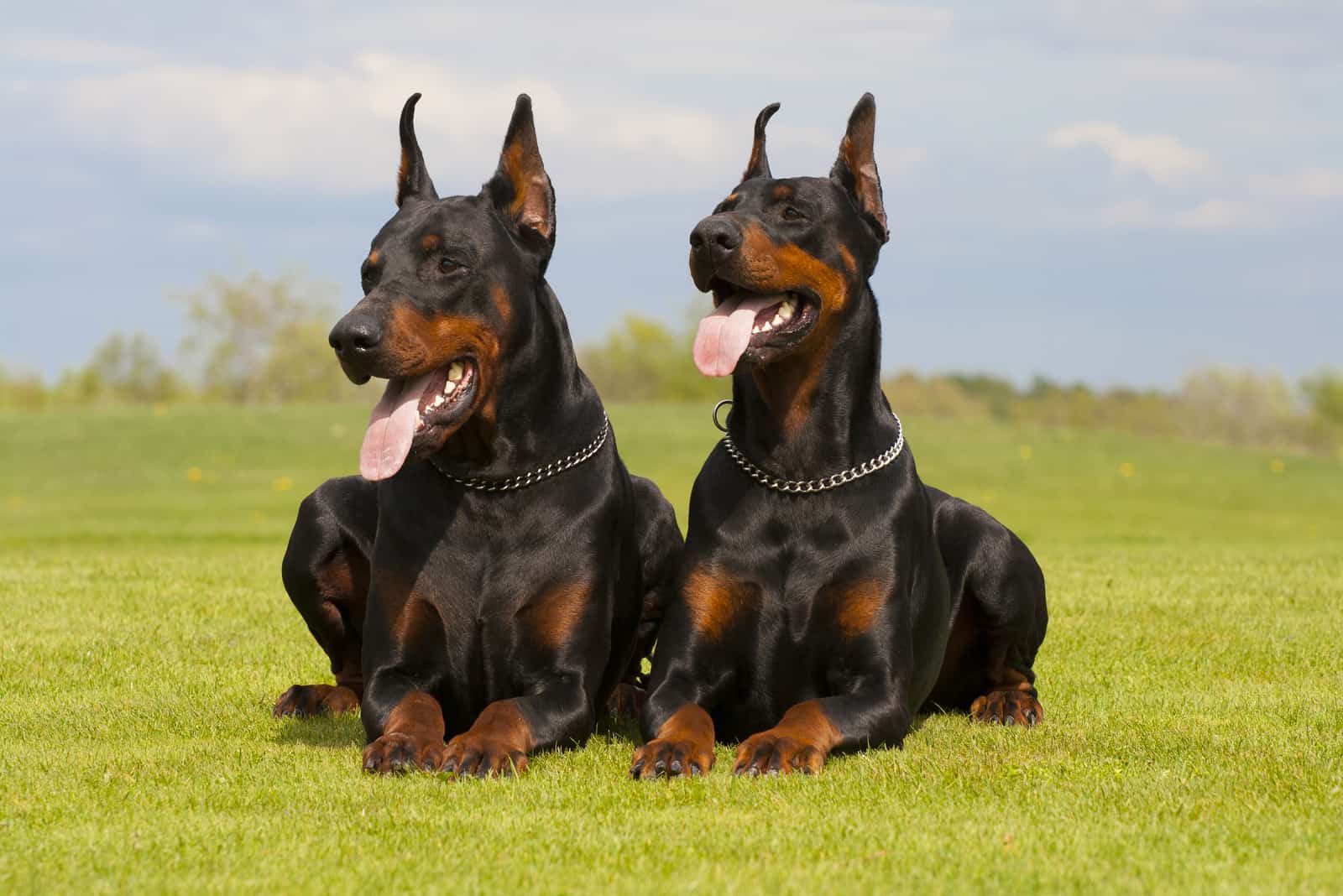
Even if your best friend is not on the list of the top 20 smartest dog breeds in the world, there’s no need to despair.
Every dog is smart in its own way, and it can even surprise you sometimes. Maybe it just likes to play dumb in order to avoid it’s responsibilities, or it’s simply so smart that it finds arbitrary tasks and tests condescending and beneath its mental prowess.
Whatever the case may be, now you know what the world’s top 20 smartest dog breeds are.
Armed with this new knowledge, you’ll always be ready for the next time someone brings up the topic of dog intelligence.
Read Next:
• The 25 Most Expensive Dog Breeds In The World—2022 Edition
• Average IQ Of A Dog: How Smart Is Your Furry Friend?















